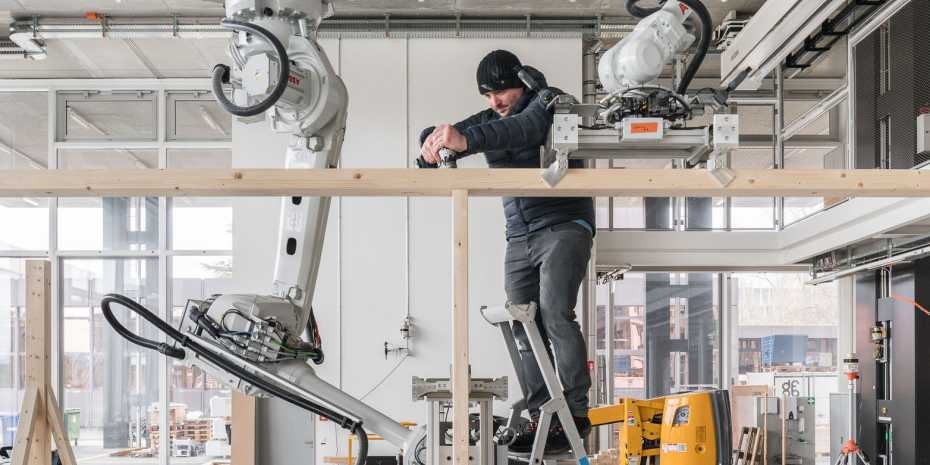Mar 29 2018
For the first time, scientists at ETH Zurich have adopted an innovative technique for digital timber construction as part of a real-time project. The load-bearing timber modules prefabricated by robots will be assembled at the DFAB HOUSE construction site, on the top two floors.
 At Spatial Timber Assemblies, man and machine work together in both the planning and the manufacturing process. (Image credit: NFS Digital Fabrication/Roman Keller)
At Spatial Timber Assemblies, man and machine work together in both the planning and the manufacturing process. (Image credit: NFS Digital Fabrication/Roman Keller)
Digitalization has marked its place in field timber construction, where computer-aided systems are already being used to construct entire elements. Although machines are used to cut the raw materials to the desired sizes, the majority of the cases still mandate manual assembly to form a plane frame. Earlier, this fabrication process was limited due to various geometric restrictions.
With support from the National Centre of Competence in Research (NCCR) Digital Fabrication, scientists from the ETH Zurich’s Chair of Architecture and Digital Fabrication have devised an innovative digital timber construction technique that has increased the probabilities for conventional timber frame construction by allowing efficient construction and assembly of geometrically complicated timber modules. Spatial Timber Assemblies was the result of a close partnership with Erne AG Holzbau and will be adopted for the first time in the DFAB HOUSE project at the Empa and Eawag NEST research and innovation construction site in Dübendorf. It is also the first large-scale architectural project to employ the construction robots created by the new Robotic Fabrication Laboratory at ETH Zurich.
With Robotic Precision
As a first step, the robot takes a timber beam and steers it to be sawn to the desired size. Following an automated tool change, another robot drills the needed holes for linking the beams. Finally, both the robots work in tandem to position the beams in the exact spatial arrangement depending on the computer layout. In order to avoid collisions while positioning the individual timber beams, the scientists have created an algorithm that continuously re-computes the path of motion of the robots based on the present state of construction. Then, workers manually bolt the beams together.
Longer Lasting, More Individual Construction
In contrast to conventional timber frame construction, Spatial Timber Assemblies can do even without reinforcement plates since the needed load-bearing and rigidity are achieved from the geometric structure. Apart from saving material, this technique also opens the door for innovative, creative probabilities. Initially, in total, six spatial, geometrically distinctive timber modules will be prefabricated by using this technique. Then, they will be shipped by Lorries to the DFAB HOUSE construction site at the NEST in Dübendorf, where they will be connected to build a two-story residential unit with a floor space of over 100 m2. The complicated geometry of the timber construction can be viewed underneath a transparent membrane façade.
Integrated Digital Architecture
Information from a computer-aided design model is used by the robots to cut and organize the timber beams. This technique was specifically devised during the project and employs a range of input parameters to develop a geometry that comprises a total of 487 timber beams.
Matthias Kohler, Professor of Architecture and Digital Fabrication at ETH Zurich and the researcher at the forefront of the DFAB HOUSE project, stated that the use of Spatial Timber Assemblies for digital fabrication and also for design and planning is highly beneficial: “If any change is made to the project overall, the computer model can be constantly adjusted to meet the new requirements. This kind of integrated digital architecture is closing the gap between design, planning, and execution.”
A Successful Concept for Sharing Knowledge
Already, ETH Zurich has successfully collaborated with Erne AG Holzbau to robot-build the timber roof of the Arch_Tech_Lab at the Hönggerberg campus. Spatial Timber Assemblies will enable the company’s expertise to be used in timber construction to make one more contribution toward research at ETH.
Kohler considers that the collaboration has induced a synergy effect: “Digital fabrication depends on the tremendous expertise required for craftsmanship. Conversely, digitalization can improve craftsmanship and open up new opportunities.” Kohler also believes that mutual collaboration between scientific disciplines and industry is a must for technologies to be used in real architectural projects within such a short period of time.
Spatial Timber Assemblies
The range of possibilities for traditional timber frame construction is expanded by the new robotic method for digital timber construction. (Video credit: NCCR Digital Fabrication)